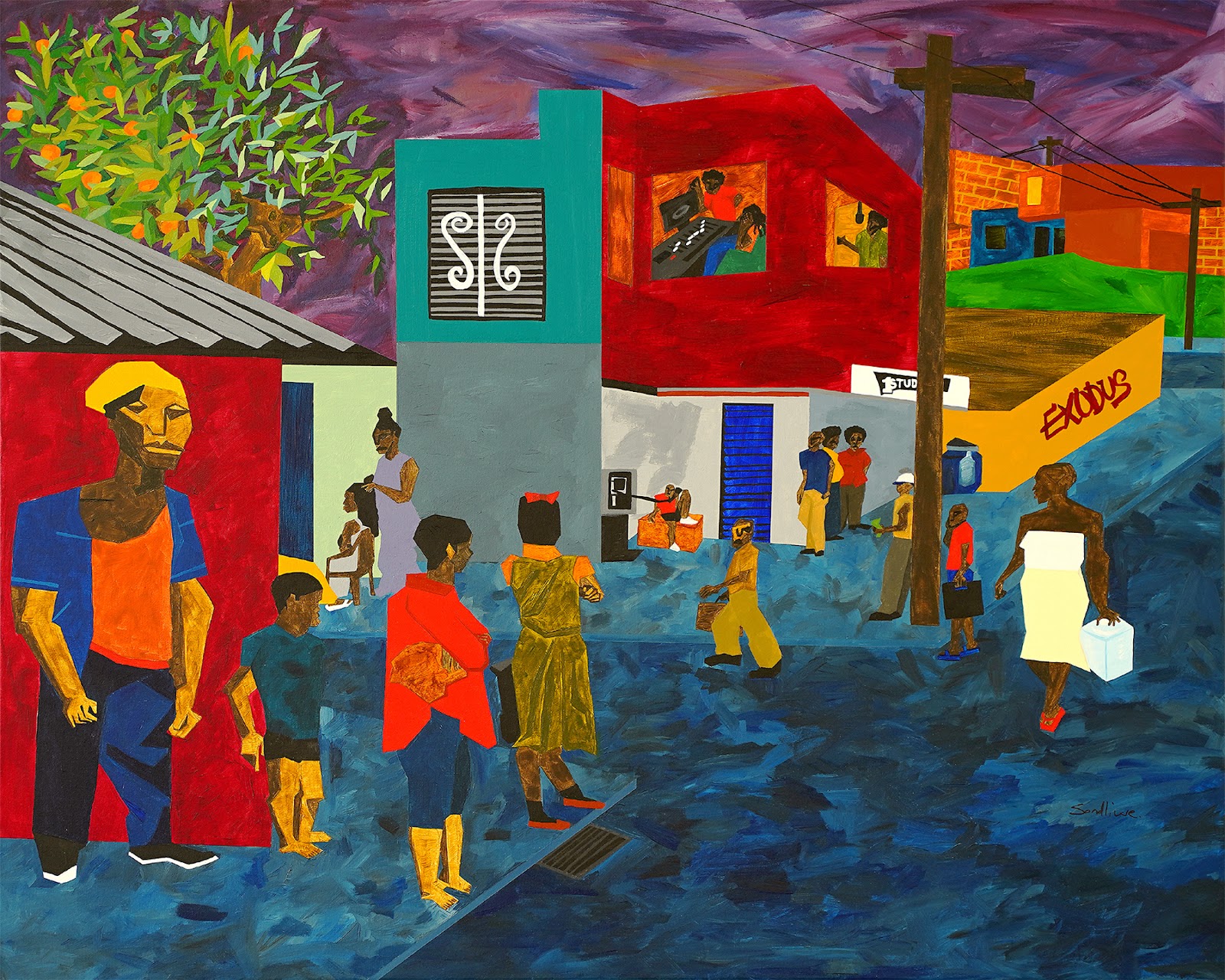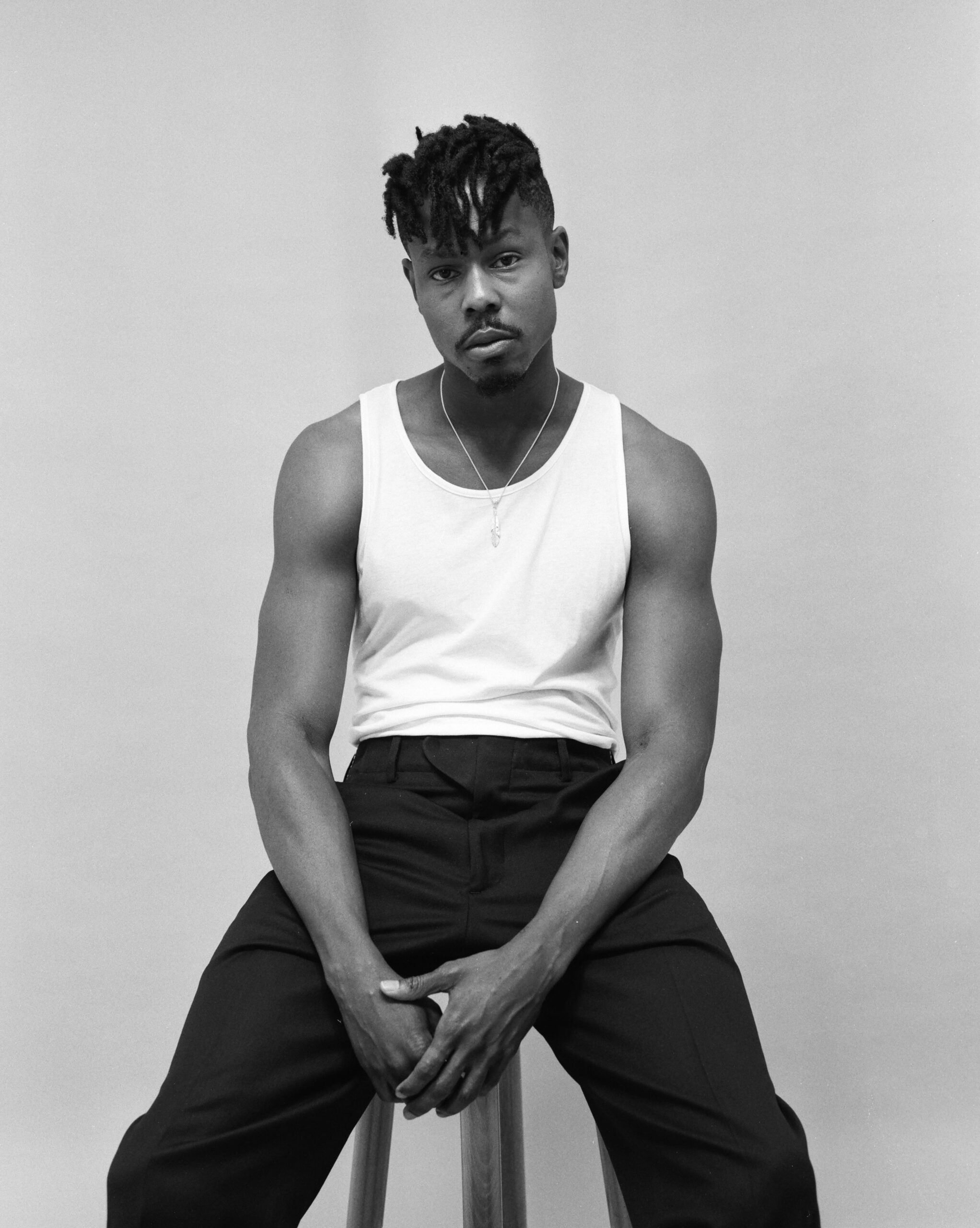The masterful depiction of everyday life – an artistic review of Lubaina Himid’s Latest Exhibition

We had the opportunity to invite the talented painter and writer, Sondliwe Pamisa, to review the latest exhibition at the Tate, showcasing the work of Lubaina Himid. Sondliwe’s work explores and chronicles the poetic and lyrical nuances of daily life, using the world around him, in particular the people that have shaped the spaces he exists in and thus, his oeuvre.
“That brudda defo Jamaican – Sondliwe Pamisa, 2021″
It’s Sondliwe’s delicate personal style and rich use of colour, used to both document and celebrate life in all its aspects, that brought him to the forefront of my mind when the opportunity to review Himid’s work came up.
Read on for Sondliwe’s review
“If there is one thing for sure that Lubaina Himid has mastered in her 40 years + career as an increasingly influential artist in the world of contemporary art, it is that of engagement. Like other artists that have earnt the prefix ‘great’ to their list of definitions, those contemporary and past, Himid weaves into her work a mirror for the world to see themselves in for who they are and who she is simultaneously. As her work in her own words ‘isn’t about being distant and admired, it is about trying to broker a deal, open a conversation’; one is able to marvel in the experience of its magnitude just how intimate and honest that conversation is able to become.
“Ball on shipboard – Lubaina Himid, 2018”
In the artist’s largest solo exhibition to date, the stage is set. To a score of sound installations created by Himid in collaboration with artist Magda Stwararska-Beavan, the audience play the vital role of performers in the scenes of rhythm and the sublime hues that coat the grand walls of Tate Modern’s theatre. Reflecting on Himid’s interest in opera and her training in theatre design, the show, presenting over 50 works that bring together painting, everyday objects, poetic texts, and sound, is truly a show. A show that offers us the rare chance to experience the breadth of Himid’s formidable and influential career. With works dating back to 1984 all the way to the present dates of the 2020’s, the experience of the work is one that has been curated with the care and time required for such an endeavour. As the highlights of the show do themselves justice in the way of deserving the recognition of highlights, one would be remiss in overlooking the quieter and more delicate moments of the overall narrative, as these are the true moments in which Himid’s mastery of engagement shine most brightly and fervently.
“There could be an endless ocean – Lubaina Himid, 2018”
With a series of questions placed throughout the exhibition, Himid asks us to consider how the built environment, history and personal relationships and conflict shape our lives. From the prelude of the show to its epilogue, we the audience are continuously asked very direct questions. As questions form the basis of her work, Himid is consistent and true to her quality as an artist whose work demands engagement from those that experience it. In offering of her personal answers to the questions posed, her work is unassuming and open to invitation in a way that still holds firm in what she knows through her personal lived experience and the experiences of others. Flags hang in the exhibition’s entrance designed like East African
Kanga Fabrics which include phrases of wisdom and affirmation, expressed through lines of poetry. Together, they are titled, How Do You Spell Change?
From the opening of the show, you are the performer, tasked with the duty of bringing all that it is you know, entering the paintings and sculptures, and deciding similarly to how you would when entering a room, what you are going to do, and how it is that you will react and interact.
“Jelly Mould – Lubaina Himid, 2010”
In the experience of new and old works, some site-specific to Tate Modern, Lubaina’s debut of work unseen, some perhaps having been kept private for quite some time, we experience the artist’s true vision. Often, the oeuvre of an artist is one that, whilst one may begin to understand it in its initial exhibition, when presented in the truly imagined context of its specific placement within the cohort of other works by the same artist, it becomes that which is more realised and refined, thus communicated with a clarity previously inexperienced. This is not to diminish the single works of an artist, particularly in this instance the work of Lubaina Himid, as many of the works featured in this show were created in the years 1998, 1999 etc.; but it is to say that, experienced in the context of this grand retrospective show, we the audience are now able to understand the pieces created then greater, and potentially in the context imagined by the artist when first conceptually conceived, which amplifies the impact and importance of those works. As we have then seen what thoughts and motifs established earlier in the artist’s oeuvre have grown to become, we experience the overall narrative being told in a more intimate and direct, ever so delicate yet with weight dialogue with ourselves and the artist.
“The operating table – Lubaina Himid, 2017/8”
It’s been a week or so since I had the pleasure of experiencing this great body of work, and I have found myself continuously in thought and awe of my experience. It is commonly said that art is something ‘that moves you’, although I have heard it be said the same for great art, and so, I often bare that thought in mind when experiencing something I find particularly enjoyable. Over the past week, and I left it for some time before writing this experience up, as I wanted to sincerely give chance for genuine thought; I have found myself reflecting in order to understand the whys and how’s and what’s of Himid’s work and I am delighted to say that I find myself still pleasantly beguiled in the ways of how she does what she does. I suppose the simplest answer to my question is that she just does it. That being said however, it is known by many of us I’m sure that, what is simple does not necessarily mean it is something to be grasped with ease.
I do however now offer a rebuttal to this point; perhaps what is simple is not something that can be grasped with ease through the process of thinking, understanding that the ways in which we think have been shaped by our experiences in the ways of education being the primary way in which we learn life; perhaps what is simple is something to be grasped with ease through the process of sincerely listening. Lubaina’s work offers specific and very direct questions which seek out and demand only honest answers. In doing so, one understands that such questions are only arrived at through the process of sincerely listening and observation. This process of sincerely listening and observing is one that as it is us that are doing it, we must begin so by doing to ourselves as our external realities are an opportunity to heal our internal upsets.
If great art is something that moves you, then we question why it moves us, and the answers to those questions we question why and why and why again.
“A fashionable marriage – Lubaina Himid, 1986. Photo by Andy Keate”
There are many things I could say and describe about Lubaina’s show at Tate, but as the audience are the performers, you must go and play your part if you truly want to know. If you truly want to understand something and do the work to be the change we want to see in this world, which I am going to be bold and make the assumption that we all want to see change in the world to some extent or in many different ways, perhaps that change being ourselves; then you must go and look into the mirror and begin to sustain the dialogue that great art demands.”
Tickets to the exhibition are discounted for Tate Members! For anyone aged 16-25 you can easily become a member by joining the Tate Collective membership for free AND get the tickets at the discounted price of £5. Sign up here: https://www.tate.org.uk/tate-collective




![ZINO VINCI’S ‘FILTHY & DISGUSTING’EP BRINGS YOU TO THE CORE OF THE ARTIST [@ZinoVinci]](https://guap.co/wp-content/uploads/2023/10/Zino-4.jpg)





![Remel London’s [@Remel_London] “Mainstream” is a must attend for upcoming presenters!](https://guap.co/wp-content/uploads/2017/02/REMEL-LONDON-FLYER-FINAL-YELLOW-COMPLETE-1.png)